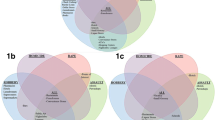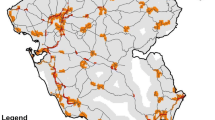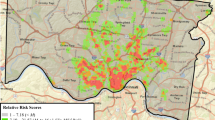Abstract
Law enforcement’s examination of vehicle crashes is often nested in the Data-Driven Approaches to Crime and Traffic Safety (DDACTS) framework which highlights the importance of hot spot analysis. To assist law enforcement efforts, this study explores how two additional spatial techniques, namely risk terrain modeling (RTM) and conjunctive analysis of case configurations (CACC), could be incorporated within the DDACTS framework. RTM was utilized to identify how the built, physical environment contributed to the risk of traffic incidents. RTM identified 6 risk factors related to the occurrence of vehicle crashes, and high-risk places were compared to hot spots on predictive accuracy. CACC was used to explore configurations likely to result in traffic incidents for the priority places. Our findings support the Theory of Risky Places and fit within a vulnerability-exposure framework, providing law enforcement with guidance for identifying places where vehicle crashes are likely to occur in the future. In addition to providing insight for law enforcement, we discuss how law enforcement can develop working partnerships with stakeholders capable of preventing and/or reducing traffic incidents, which is in line with the general DDACTS framework.



Similar content being viewed by others
Notes
Gas and convenience stores also included liquor and tobacco stores. There were overlap between many of the descriptions so we aggregated to one factor.
A spatial lag option is not currently available in the RTMDx software (see Heffner, 2013).
Parameters in the PAI formula include: n, which represents the number of crimes in areas where crimes are predicted to occur; N, which is the number of crimes in the study area; a, which represents the area of areas where crimes are predicted to occur, and A, which is the area of the study area.
It is possible to do this manually, but RTMDx does not currently output the combination configurations.
References
Barnum, J. D. (2016). Tutorial for conjunctive analysis of risk factors configurations (CARFC) Newark. NJ: Rutgers Center on Public Security.
Barnum, J. D., Caplan, J. M., Kennedy, L. W., & Piza, E. L. (2017). The crime kaleidoscope: A cross-jurisdictional analysis of place features and crime in three urban environments. Applied Geography, 79, 203–211.
Brantingham, P. L., and Brantingham, P. J. (1993). Nodes, paths and edges: Considerations on the complexity of crime and the physical environment. Journal of Environmental Psychology, 13(1), 3–28.
Caplan, J. M., and Kennedy, L. W. (2016). Risk terrain modeling: Crime prediction and risk reduction. University of California Press.
Caplan, J.M., Kennedy, L.W., Barnum, J.D., and Piza, E.L. (2017). “Crime in Context: Utilizing Risk Terrain Modeling and Conjunctive Analysis of Case Configurations to Explore the Dynamics of Criminogenic Behavior Settings.” Journal of Contemporary Criminal Justice, [Online first].
Caplan, J. M., Kennedy, L. W., and Piza, E. L. (2013). "Joint Utility of Event-Dependent and Environmental Crime Analysis Techniques for Violent Crime Forecasting." Crime & Delinquency, 59(2), 243–270.
Caplan, J. M., Kennedy, L. W., Barnum, J. D., & Piza, E. L. (2015). Risk terrain modeling for spatial risk assessment. Cityscape: A Journal of Policy Development and Research, 17(1), 7–16.
Carter, J.G. and Piza, E.L. (2017). “Spatiotemporal Convergence of Crime and Vehicle Crash Hotspots: Additional Consideration for Policing Places.” Crime & Delinquency, [Online first].
Chainey, S., Tompson, L., & Uhlig, S. (2008). The utility of hotspot mapping for predicting spatial patterns of crime. Security Journal, 21, 4–28.
Chillar, V.F. and Drawve, G. (2018). “Unpacking Spatio-temporal differences of risk for crime: An analysis in Little Rock, Arkansas.” Policing: A Journal of Policy and Practice.
Cohen, L. E., & Felson, M. (1979). Social change and crime rate trends: A routine activity approach. American Sociological Review, 44(4), 588–608.
Daley, D., Bachmann, M., Bachmann, B. A., Pedigo, C., & Bui, M. T. (2016). Risk terrain modeling predicts child maltreatment. Child Abuse & Neglect, 62, 29–38.
Delaney, C. (2010). Using geographic analysis to direct DDACTS operations in Rochester. Geography Public Safety, 2(3), 12–15.
Drawve, G. (2016). A metric comparison of predictive hot spot techniques and RTM. Justice Quarterly, 33(3), 369–397.
Drawve, G. and Barnum, J.D. (2017). “Place-Based Risk Factors for Aggravated Assault across Police Divisions in Little Rock, Arkansas.” Journal of Crime and Justice, [Online first].
Drawve, G., Thomas, S. A., & Hart, T. C. (2017). Routine activity theory and the likelihood of arrest: A replication and extension with conjunctive methods. Journal of Contemporary Criminal Justice, 33(2), 121–132.
Drawve, G., Belongie, M., and Steinman, H. (2017). “The Role of Crime Analyst and Researcher Partnerships: A Training Exercise in Green Bay, Wisconsin.” Policing: A Journal of Policy and Practice, [Online First].
Dugato, M. (2013). "Assessing the validity of risk terrain modeling in a European City: Preventing robberies in the city of Milan" Crime Mapping 5(1), 63–89.
Dugato, M., Calderoni, F., and Berlusconi, G. (2017) “Forecasting organized crime homicides: Risk terrain modeling of camorra violence in Naples, Italy”. Journal of Interpersonal Violence, [online first].
Dumbaugh, E., & Li, W. (2010). Designing for the safety of pedestrians, cyclists, and motorists in urban environments. Journal of the American Planning Association, 77(1), 69–88.
Escudero, J. A., & Ramirez, B. (2018). Risk terrain modeling for monitoring illicit drugs markets across Bogota, Colombia. Crime Science, 7(3), 1–10.
Garnier, S., Caplan, J. M., & Kennedy, L. W. (2018). Predicting dynamical crime distribution from environmental and social influences. Frontiers in Applied Mathematics and Statistics, 4(13), 1–10.
Goldstein, H. (1990). Problem-Oriented Policing. Philadelphia: Temple University Press.
Hardy, E. (2010). Data-driven policing: How geographic analysis can reduce social harm. Geography & Public Safety, 2(3), 1–3.
Hart, T.C. (2014). Conjunctive Analysis of Case Configurations. JDiBrief series. London: UCL Jill Dando Institute of Security and Crime Science.
Hart, T. C., & Miethe, T. D. (2011). Violence against college students and its situational contexts: Prevalence, patterns, and policy implications. Victims and Offenders, 6(2), 157–180.
Hart, T. C., & Miethe, T. D. (2015). Configural behavior settings of crime event locations: Toward an alternative conceptualization of Criminogenic microenvironments. Journal of Research in Crime and Delinquency, 52(3), 373–402.
Hart, T. C., Rennison, C. M., & Miethe, T. D. (2017). Identifying patterns of situational clustering and contextual variability in criminological data: An overview of conjunctive analysis of case configurations. Journal of Contemporary Criminal Justice, 33(2), 112–120.
Hall, H., & Puls, E. (2010). Implementing DDACTS in Baltimore County: Using geographic incident patterns to deploy enforcement. Geography & Public Safety, 2, 5–8.
Heffner, J. (2013). Statistics of the RTMDx utility. In J. M. Caplan, W. Kennedy, & E.L. Piza (eds.), Risk Terrain Modeling Diagnostics Utility User Manual, Version 1.0. Newark, NJ: Rutgers Center on Public Security.
Kennedy, L. W., & Caplan, J. M. (2013). A theory of risky places. Research brief. Newark: Rutgers Center on Public Security.
Kennedy, L.W., Caplan, J.M., Piza, E.L., Buccine-Schraeder, H. 2016. “Vulnerability and exposure to crime: Applying risk terrain modeling to the study of assault in Chicago.” Applied Spatial Analysis.
Kuo, P.F., Zeng, X., and Lord, D. (2011). “Guidelines for Choosing Hot-Spot Analysis Tools Based on Data Characteristics, Network Restrictions, and Time Distributions.” Transportation Research Board, 1–21.
LaScala, E. A., Johnson, F. W., & Gruenewald, P. J. (2001). Neighborhood characteristics of alcohol-related pedestrian injury collisions: A geospatial analysis. Prevention Science, 2(2), 123–134.
Lee, J., Abdel-Aty, M., Choi, K., & Huang, H. (2015). Multi-level hot zone identification for pedestrian safety. Accident Analysis & Prevention, 76, 64–73.
Lersch, K. M. (2017). Risky places: An analysis of Carjackings in Detroit. Journal of Criminal Justice, 52, 34–40.
Malleson, N., & Andresen, M. A. (2015). Spatio-temporal crime hotspots and the ambient population. Crime Science, 4(10). https://doi.org/10.1186/s40163-015-0023-8
McClure, D., Levy, J., La Vigne, N., and Hayeslip, D. (2014). DDACTS Evaluability Assessment: Final Report on Individual and Cross-Site Findings (report no. 247889). Washington, DC: Urban Institute.
Miethe, T. D., Hart, T. C., & Regoeczi, W. C. (2008). The conjunctive analysis of case configurations: An exploratory method for discrete multivariate analyses of crime data. Journal of Quantitative Criminology, 24(2), 227–241.
Mitra, S., & Washington, S. (2012). On the significance of omitted variables in intersection crash modeling. Accident Analysis & Prevention, 49, 439–448.
Morency, P., Archambault, J., Cloutier, M. S., Tremblay, M., & Plante, C. (2015). Major urban road characteristics and injured pedestrians: A representative survey of intersections in Montreal, Quebec. Canadian Journal of Public Health, 106(6), 388–394.
Moreto, W. D., Piza, E. L., & Caplan, J. M. (2014). ‘A plague on both your houses?’: Risks, repeats and reconsiderations of urban residential burglary. Justice Quarterly, 31(6), 1102–1126.
National Highway Traffic Safety Administration. (2014). Data driven approaches to crime and traffic safety (DDACTS): Operational guide. (Report no. DOT HS 811 185). Washington, DC.
Onat, I. (2016). “An Analysis of Spatial Correlates of Terrorism using Risk Terrain Modeling.” Terrorism and Political Violence, [Online first].
Piza, E.L. and Feng, S.Q. (2017). “The Current and Potential Role of Crime Analysts in Evaluations of Police Interventions: Results from a Survey of the International Association of Crime Analysts.” Police Quarterly, [Online first].
Piza, E., Feng, S., Kennedy, L., and Caplan, J. (2016). “Place-Based Correlates of Motor Vehicle Theft and Recovery: Measuring Spatial Influence across Neighbourhood Context.” Urban Studies, [Online first].
Ratcliffe, J. H. (2016). Intelligence-led policing (2nd ed.). New York, NY: Routledge.
Retting, R. A., Ferguson, S. A., & McCartt, A. T. (2003). A review of evidence-based traffic engineering measures designed to reduce pedestrian–motor vehicle crashes. American Journal of Public Health, 93(9), 1456–1463.
Rothman, L., Macarthur, C., To, T., Buliung, R., & Howard, A. (2014). Motor vehicle-pedestrian collisions and walking to school: The role of the built environment. Pediatrics, 133(5), 776–784.
Santos, R. B. (2014). The effectiveness of crime analysis for crime reduction: Cure or diagnosis? Journal of Contemporary Criminal Justice, 30(2), 147–168.
Schuurman, D., Cinnamon, J., Crooks, V. A., & Hameed, S. M. (2009). Pedestrian injury and the built environment: An environmental scan of hotspots. BMC Public Health, 9, 233.
Sherman, L. W., Gartin, P. R., & Buerger, M. E. (1989). Hot spots of predatory crime: Routine activities and the criminology of place. Criminology, 27(1), 27–56.
Townsley, M., & Pease, K. (2002). Hot spots and cold comfort: The importance of having a working thermometer. Crime Prevention Studies, 13, 59–69.
Marshall, W. E., & Garrick, N. W. (2011). Does street network design affect traffic safety? Accident Analysis & Prevention, 43(3), 769–781.
U.S. Census Department. (2018). Retrieved from: https://www.census.gov/quickfacts/fact/table/US/PST045217. Accessed 31 July 2018.
Weisburd, D., & Green, L. (2006). Policing drug hot spots: The Jersey City drug market analysis experiment. Justice Quarterly, 12(4), 711–735.
Wilson, R. E. (2010). Place as the focal point: Developing a theory for the DDACTS1 model. Geography & Public Safety, 2(3), 3–4.
World Health Organization. (2004). World report on road traffic injury prevention. In M. Peden, R. Scurfield, D. Sleet, D. Mohan, A. A. Hyder, E. Jarawan and C. Mathers (Eds.). Geneva: WHO.
Wyatt, J. (2010). Integrating crime and traffic crash data in Nashville. Geography & Public Safety, 2(3), 9–11.
Author information
Authors and Affiliations
Corresponding author
Rights and permissions
About this article
Cite this article
Drawve, G., Grubb, J., Steinman, H. et al. Enhancing Data-Driven Law Enforcement Efforts: Exploring how Risk Terrain Modeling and Conjunctive Analysis Fit in a Crime and Traffic Safety Framework. Am J Crim Just 44, 106–124 (2019). https://doi.org/10.1007/s12103-018-9449-3
Received:
Accepted:
Published:
Issue Date:
DOI: https://doi.org/10.1007/s12103-018-9449-3




